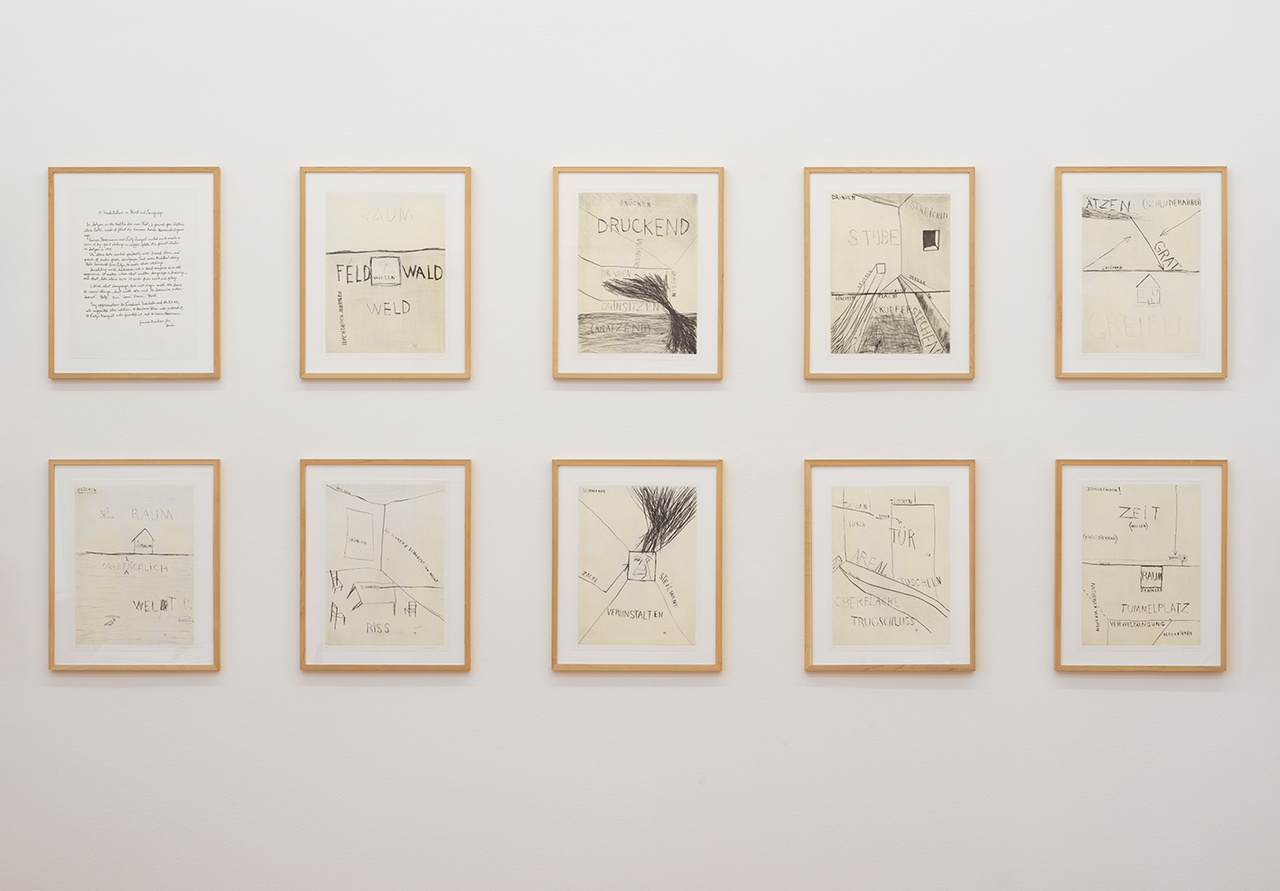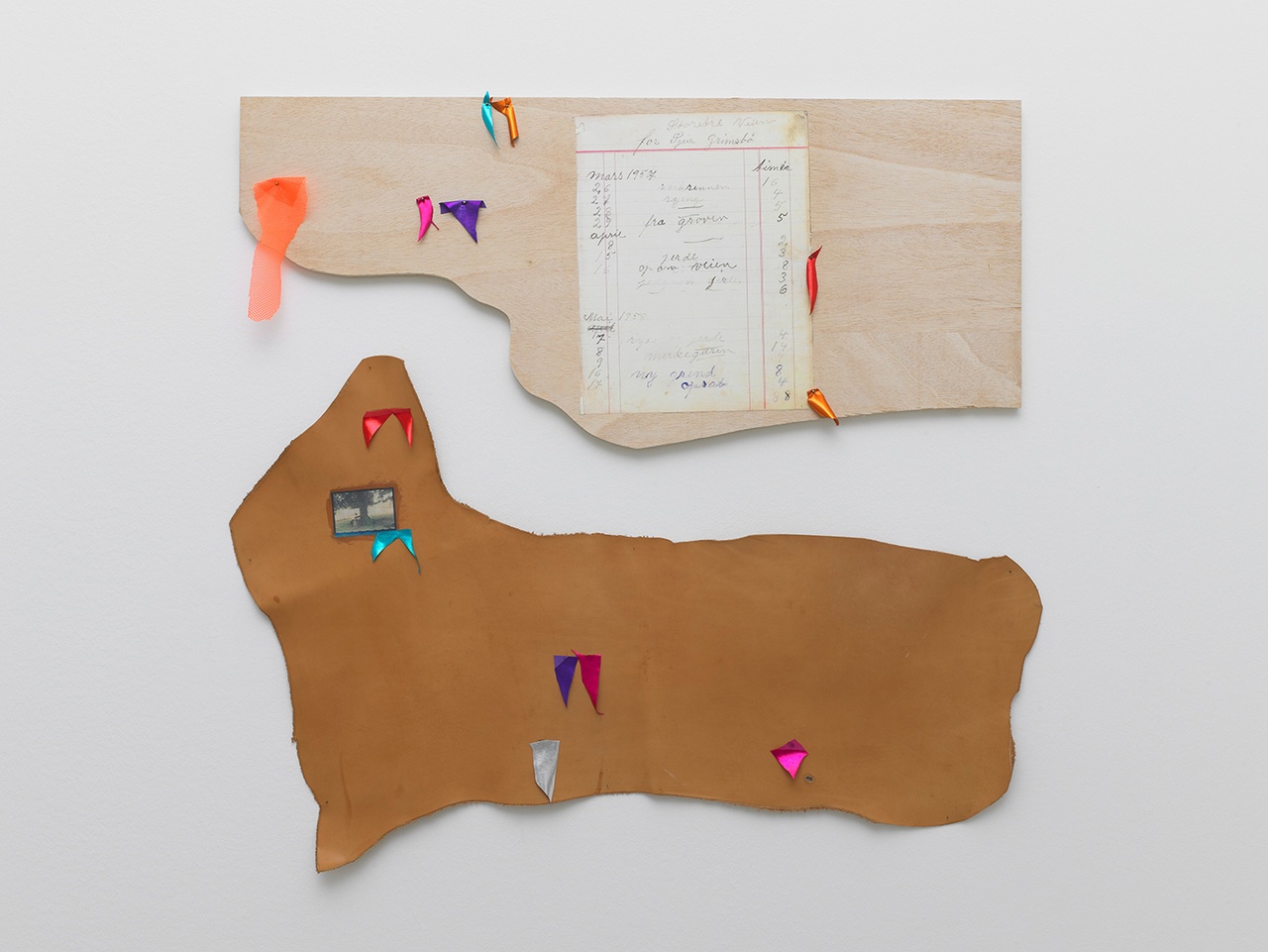AFTER JIMMIE DURHAM Jess Chen on Jimmie Durham at Barbara Wien, Berlin

Jimmie Durham, “Mäßige Materialfehler,” 2000
In 1988, Jimmie Durham remarked, “I feel fairly sure that I could address the entire world if only I had a place to stand.” The first half of this oft-quoted statement, his ambition to meet and metabolize the world in his art, is hardly contested; the second, where Durham’s “place to stand” is and whether it is his to take, has been a source of controversy for decades. During his 2017 North American retrospective, “Jimmie Durham: At the Center of the World,” a group of Native scholars, activists, and artists published an open letter that accused Durham of falsely claiming Cherokee heritage and exploiting the trust of others to position himself as a major Native artist. [1] At his latest show at Barbara Wien, however, the firestorm over Durham’s identity is presented as little more than a spark. The press release describes Durham simply as an “artist and author,” an apt description for a show that seeks to distance his text-based work from the prescriptive aegis of identity. [2] In other words, why not treat Jimmie Durham as a racially unmarked (i.e., white) artist?
Granted, Durham’s identity does receive some mention, as is consistent with nearly any solo show, but its lack of emphasis shifts the show’s focus to the diversity of written material about and by Durham. Two freestanding glass vitrines display yellowing exhibition brochures and posters, stickers printed with pithy quotes, and several pages of his essays. One text, written in the authoritative tone of the exhibition blurb, states that he is Cherokee, full stop. Another hedges the issue by saying that he is of Cherokee descent – the unspoken suggestion that he might not be culturally Cherokee. These anonymous and putatively neutral texts are shown alongside Durham’s ludic essays, which eschew linearity in favor of disjunction, faux-explanation, and wandering storylines. In “My Family Tree,” he recounts his journey across Mongolia and Siberia in search of people who might know his ancestors, those who might have walked across the Bering Strait to North America. Considering the land bridge crossing happened at least 16,000 years ago, the work is a satire of the genealogical impulse – go back far enough, and no one knows their family history – albeit one tinged with melancholy. His essay makes clear how vast the distances traveled are, how futile the effort to root oneself is, and how lonely. No single text stakes a normative claim to Durham’s biography; instead, conflicting voices, some “objective” and official, others scopic and playful, susurrate through his numerous publications and ephemera.

Jimmie Durham, “Road Work and Nostalgia,” 2022
That Durham’s first solo show since his death in 2021 focuses on his poetry and essays is notable, given that his writing was seen as an ancillary force in his practice. Catholic in form and subject matter, Durham’s writing could not slot easily into discourses around Nativeness that shaped discussions of his visual work. The show minimizes that discursive frame in favor of orienting the viewer toward Durham’s critical approach to language. Mäßige Materialfehler (2000) includes nine etchings on copper plates; each one documents Durham’s attempt to construct spatial relationships between German words through a distinct vocabulary of diagrammatic sketches, deeply incised partition lines, and blocky capitals. As hinted by the title, Durham’s attention to material is paramount. He carved, inscribed, and engraved words using a combination of prehistoric stone, broken glass, sandpaper, and conventional etching tools. The letters are clunky, misshapen, and imperfect – obviously handwritten. His laborious etching process emphasizes the haptic qualities of language and interprets language as a mediated visual system that refers outward, toward spaces of action. In this respect, Durham seems to improvise on J. L. Austin’s theory of speech acts without assuming facile engagement with other languages and their nuances.
Rather, Durham points out what is not porous, what cannot permeate, what does not translate, and what remains – a perspective that also reflects his turn toward the physical sciences as a source of inspiration. In the gallery, a short video clip of him reading from his most recent collection, Particle/Word Theory (2020), loops on a monitor; other poems are mounted on wooden planks in another room. One poem lists article titles from the September 2015 issue of Nature Materials Magazine, whose mentions of “Janus-like nanoparticle membranes” and “nanoporous gold” are as inscrutable as they are alluring. Another points out idiomatic English phrases such as “out of the blue” that have slipped into common usage through repetition but are otherwise enigmatic. [3] Epistrophe, slant rhyme, parenthesis, antimetabole – these literary and rhetorical devices are Durham’s tools for dismantling the myth of language as a mode of clear communication. His poetry extends ideas put forth in his sculptures, succinctly described as “against architecture, against narration, against structure,” and argues for the indispensability of Durham’s texts to our understanding of his worldview. [4]
Interlocutory drawings from Particle/Word Theory, framed and hung in the show, express Durham’s anti-monumental stance outside the realm of language. In one work, a crisp line of ink scuds across creamy paper to form sharp corners and jutting angles, while a softer pencil line loops forward and backward, lending the drawing a sense of stochastic movement. Austere construction gives way to fuzzier lines, a path lacking beginning and end. It looks like an architectural sketch imploding, a diagram that visualizes the logic of Durham’s anti-structure ethos.
The freewheeling exterior of his work notwithstanding, Durham astutely critiques institutional power and its textual disguises. Pissing in Germany (2012), a series of printed texts mounted on wood, confronts the absurdity of Deutsche Bahn’s 50-euro-cent Wert-Bon, which one receives after paying a euro to use the restroom. The Wert-Bon, or voucher, is blown up to poster size but otherwise untreated, as though to magnify the ridiculousness of its bureaucratic language. Not only is the human right to use a toilet restricted (Durham observes that one mother could not find enough coins before her child needed to use the bathroom), but the so-called voucher incentivizes spending yet more money in the train-station stores.
Durham’s commentary on capitalist greed also looks toward the market for his own work; as he once noted, “it’s easier to sell objects than it is to sell poems.” [5] However, the gallery’s architecture is cleverly deployed to assert the significance of Durham’s work outside the context of his objects, often read through his (Cherokee or not) identity. One narrow hallway features several large works on paper, mostly of human and animal heads with round eyes outlined in cobalt and turquoise blues, red, and green. Scribbled pupils and flat, emotionless mouths seem to preclude the ability to speak or even communicate. By appropriating an overdetermined register of Native and “folk art” aesthetics, Durham’s transformation of a face into an inanimate object may have been conceived as a critique of popular representations of Indigeneity, but the very success of his career, particularly earlier works with skulls and other objects that could be attributed to a stereotypically Native aesthetic, belies his intention. The hallway is a dead end literally and figuratively. One end opens into the entryway and the other is closed off, thwarting any chance of dialogue with the rest of the show.
In 1964, Durham began writing poetry, a practice that would continue in parallel to his visual output until his passing. Books of essays and poems chart the development of his razor-sharp political wit, his polemics against insidious structures of power, and his intense curiosity about a wide range of topics. Though Durham rejected the label “Cherokee artist” in later years, it boomeranged back to him; the literature on him almost exclusively centers his sculptures and mixed-media work and reads them through the framework of Indigenous art history. [6] His claim to Cherokee identity, regardless of its veracity, trapped him within the boundaries of Native representational space. [7] That makes evaluating his work along a binary – Is he or isn’t he? – unproductive at best, because both possibilities lead to the same line of inquiry. By bringing Durham’s writing into focus, the show at Barbara Wien succeeds in reconsidering his oeuvre outside those parameters. It provides an example of what artists sacrifice, willingly or not, to be legible in spaces of visibility, and it does so without fanfare. No monuments are erected, no grand theses trumpeted; true to Jimmie Durham, the show builds a place to stand.
“Jimmie Durham: Texts and Recordings,” Barbara Wien, Berlin, February 12–April 2, 2022.
Jess Chen is a critic and art historian from San Francisco.
Image credit: Courtesy of Galerie Barbara Wien, Berlin and the Estate of Jimmie Durham, photos Nick Ash
Notes
| [1] | Cara Cowan Watts, et al., “Dear Unsuspecting Public, Jimmie Durham Is a Trickster,” Indian Country Today, June 26, 2017 . The curator of “Jimmie Durham: At the Center of the World,” Anne Ellegood, published a response to the open letter; see “Curator Anne Ellegood on Understanding the Complexities of Jimmie Durham’s Native Identity,” Artnet News, August 2, 2017. |
| [2] | Barbara Wien, “Jimmie Durham: Texts and Recordings,” press release, February 2022. |
| [3] | Jimmie Durham, Particle/Word Theory (Berlin: Wiens Verlag, 2020). |
| [4] | Jimmie Durham, interview by Manuel Cirauqui, BOMB, no. 118 (January 1, 2012): 78. |
| [5] | Jimmie Durham, The Usual Song and Dance Routine with a Few Minor Interruptions, How to Write – Artists who Write (Berlin: Wiens Verlag, 2013/2014). |
| [6] | One of the earliest examples of his disavowal of Cherokee identity appeared in Art in America, where he wrote, “I am not Cherokee. I am not an American Indian. This is in concurrence with recent US legislation [a reference to the 1990 Indian Arts and Crafts Act].” See Jimmie Durham, Lucy R. Lippard, and Nancy Marie Mitchell, “Letters,” Art in America 81, no. 7 (July 1993): 23. |
| [7] | I am using the term Native representational space as an extension of Darby English’s formulations of black representational space, specifically that “the rhetorical operations of black representational space separate from works of art elements of their informing contexts that reflect interest in issues other than race,” which is presented in the introduction to his book How to See a Work of Art in Total Darkness (Cambridge: MIT Press, 2007), 12. |
